Nursing Case Study: Comprehensive Patient Assessment and Care Planning
VerifiedAdded on 2022/09/16
|12
|3393
|17
Homework Assignment
AI Summary
This assignment presents a detailed nursing case study involving a 48-year-old male patient presenting with chronic fatigue and chest pain. The student analyzes the patient's subjective and objective data, including vital signs and lab results. The assignment explores relevant national guidelines, appropriate diagnostic tests (such as ECG and X-rays), and the need for consultations. It addresses medical and nursing diagnoses, ethical considerations in pain management, and treatment plans, including medications and complementary therapies. Additionally, the assignment connects the case to Healthy People 2020 objectives and discusses the components of the circle of care, such as finding the right provider, health insurance, and accurate diagnosis. The student demonstrates an understanding of comprehensive patient assessment and care planning within a nursing context.
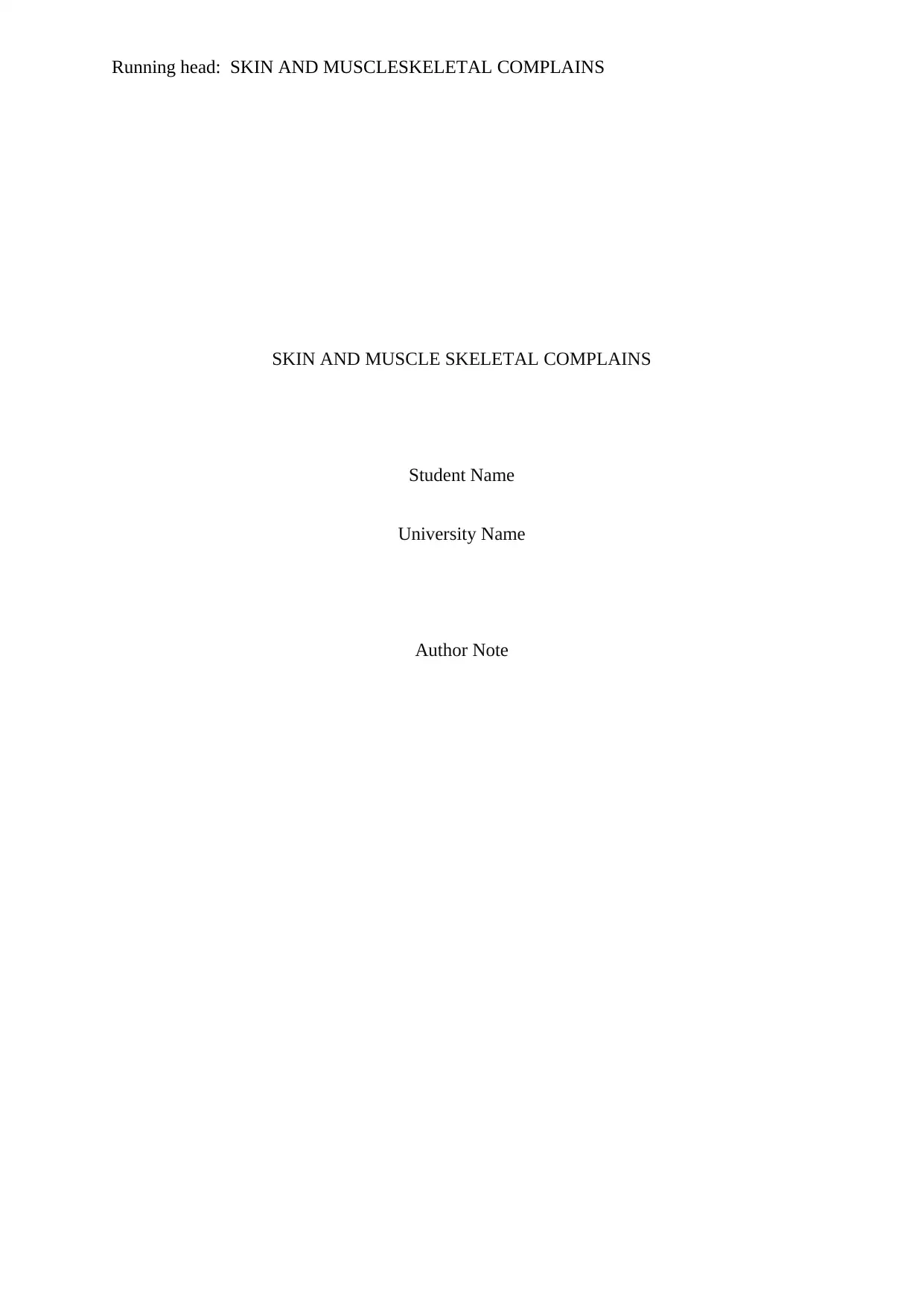
Running head: SKIN AND MUSCLESKELETAL COMPLAINS
SKIN AND MUSCLE SKELETAL COMPLAINS
Student Name
University Name
Author Note
SKIN AND MUSCLE SKELETAL COMPLAINS
Student Name
University Name
Author Note
Paraphrase This Document
Need a fresh take? Get an instant paraphrase of this document with our AI Paraphraser
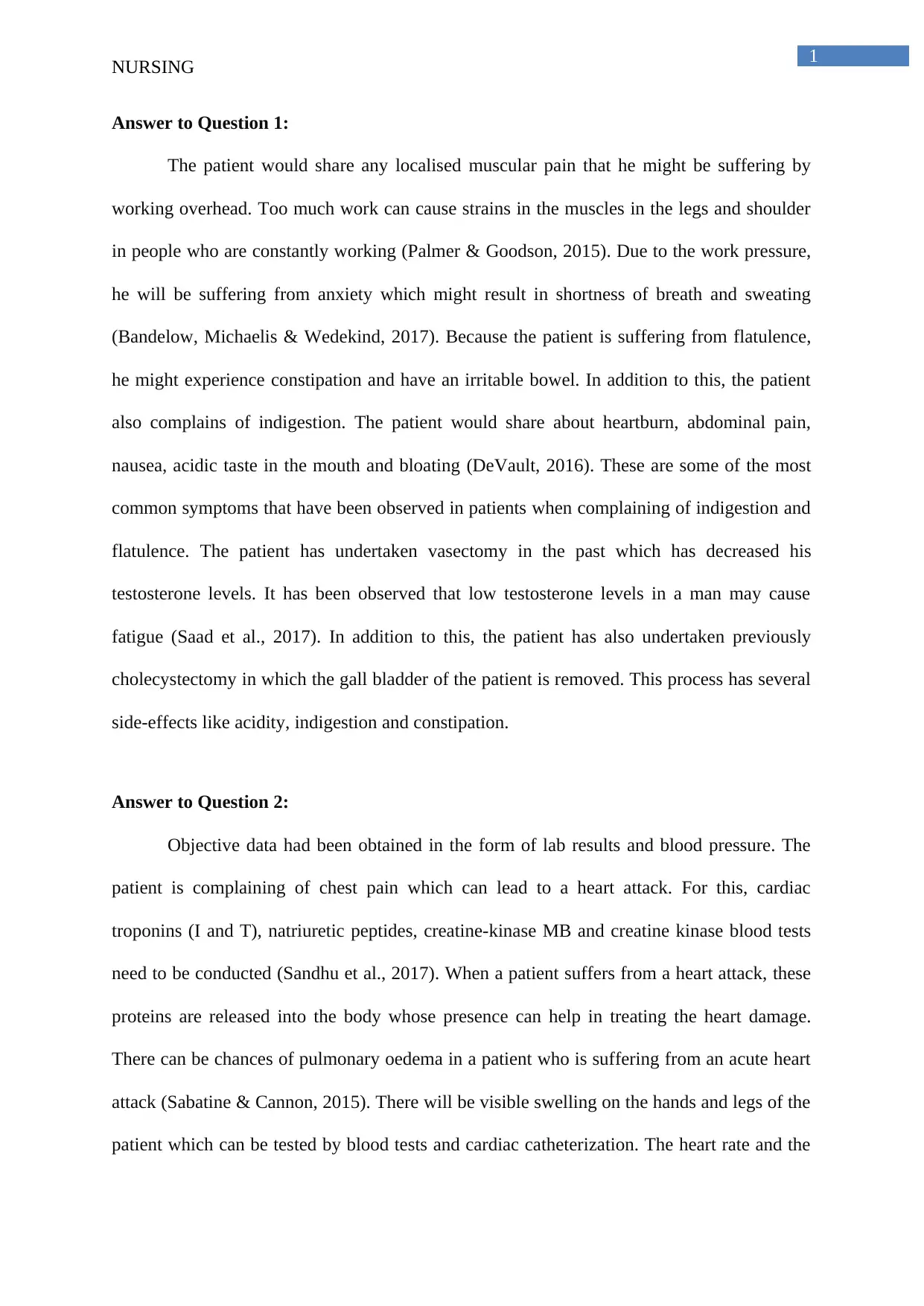
1
NURSING
Answer to Question 1:
The patient would share any localised muscular pain that he might be suffering by
working overhead. Too much work can cause strains in the muscles in the legs and shoulder
in people who are constantly working (Palmer & Goodson, 2015). Due to the work pressure,
he will be suffering from anxiety which might result in shortness of breath and sweating
(Bandelow, Michaelis & Wedekind, 2017). Because the patient is suffering from flatulence,
he might experience constipation and have an irritable bowel. In addition to this, the patient
also complains of indigestion. The patient would share about heartburn, abdominal pain,
nausea, acidic taste in the mouth and bloating (DeVault, 2016). These are some of the most
common symptoms that have been observed in patients when complaining of indigestion and
flatulence. The patient has undertaken vasectomy in the past which has decreased his
testosterone levels. It has been observed that low testosterone levels in a man may cause
fatigue (Saad et al., 2017). In addition to this, the patient has also undertaken previously
cholecystectomy in which the gall bladder of the patient is removed. This process has several
side-effects like acidity, indigestion and constipation.
Answer to Question 2:
Objective data had been obtained in the form of lab results and blood pressure. The
patient is complaining of chest pain which can lead to a heart attack. For this, cardiac
troponins (I and T), natriuretic peptides, creatine-kinase MB and creatine kinase blood tests
need to be conducted (Sandhu et al., 2017). When a patient suffers from a heart attack, these
proteins are released into the body whose presence can help in treating the heart damage.
There can be chances of pulmonary oedema in a patient who is suffering from an acute heart
attack (Sabatine & Cannon, 2015). There will be visible swelling on the hands and legs of the
patient which can be tested by blood tests and cardiac catheterization. The heart rate and the
NURSING
Answer to Question 1:
The patient would share any localised muscular pain that he might be suffering by
working overhead. Too much work can cause strains in the muscles in the legs and shoulder
in people who are constantly working (Palmer & Goodson, 2015). Due to the work pressure,
he will be suffering from anxiety which might result in shortness of breath and sweating
(Bandelow, Michaelis & Wedekind, 2017). Because the patient is suffering from flatulence,
he might experience constipation and have an irritable bowel. In addition to this, the patient
also complains of indigestion. The patient would share about heartburn, abdominal pain,
nausea, acidic taste in the mouth and bloating (DeVault, 2016). These are some of the most
common symptoms that have been observed in patients when complaining of indigestion and
flatulence. The patient has undertaken vasectomy in the past which has decreased his
testosterone levels. It has been observed that low testosterone levels in a man may cause
fatigue (Saad et al., 2017). In addition to this, the patient has also undertaken previously
cholecystectomy in which the gall bladder of the patient is removed. This process has several
side-effects like acidity, indigestion and constipation.
Answer to Question 2:
Objective data had been obtained in the form of lab results and blood pressure. The
patient is complaining of chest pain which can lead to a heart attack. For this, cardiac
troponins (I and T), natriuretic peptides, creatine-kinase MB and creatine kinase blood tests
need to be conducted (Sandhu et al., 2017). When a patient suffers from a heart attack, these
proteins are released into the body whose presence can help in treating the heart damage.
There can be chances of pulmonary oedema in a patient who is suffering from an acute heart
attack (Sabatine & Cannon, 2015). There will be visible swelling on the hands and legs of the
patient which can be tested by blood tests and cardiac catheterization. The heart rate and the
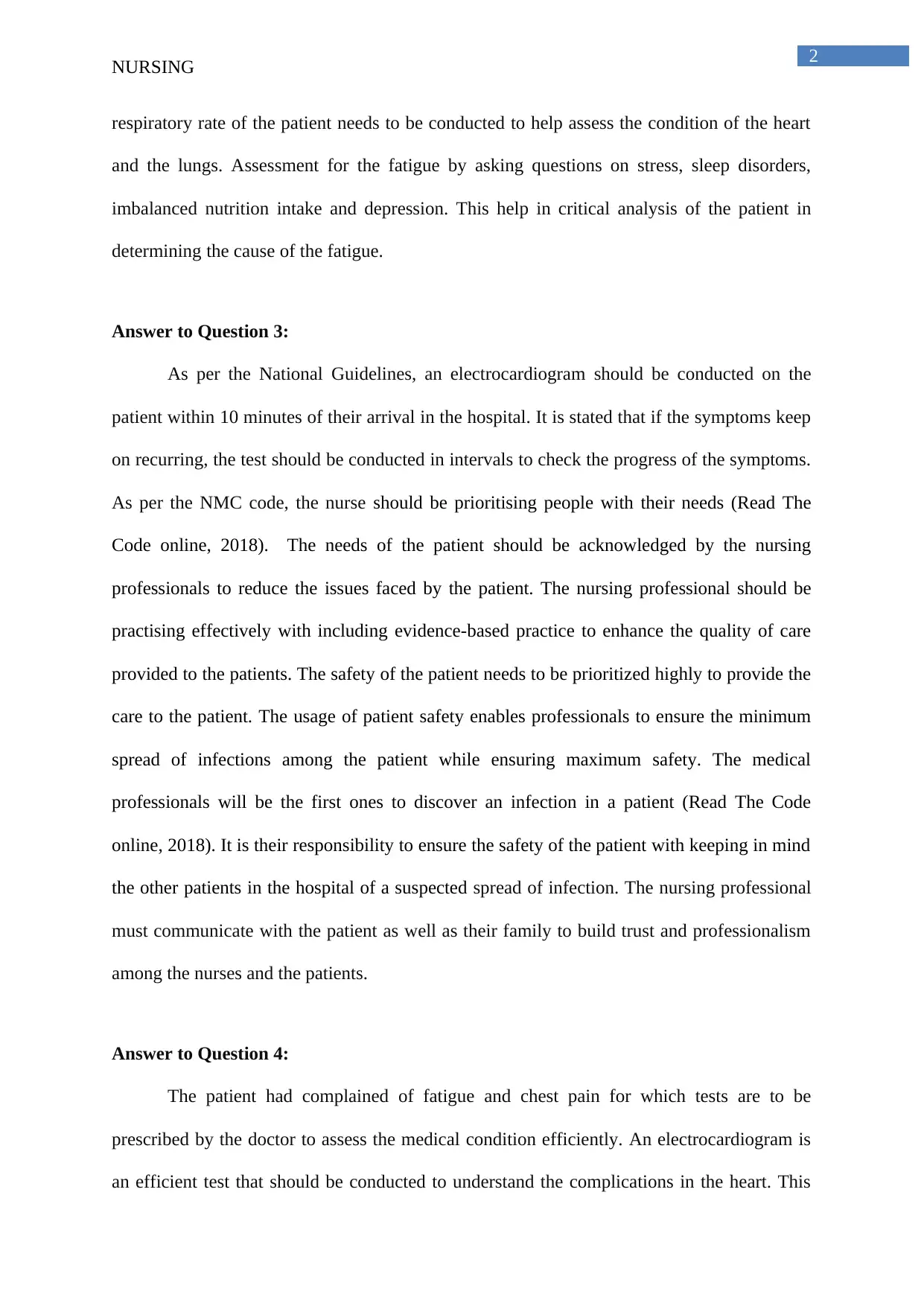
2
NURSING
respiratory rate of the patient needs to be conducted to help assess the condition of the heart
and the lungs. Assessment for the fatigue by asking questions on stress, sleep disorders,
imbalanced nutrition intake and depression. This help in critical analysis of the patient in
determining the cause of the fatigue.
Answer to Question 3:
As per the National Guidelines, an electrocardiogram should be conducted on the
patient within 10 minutes of their arrival in the hospital. It is stated that if the symptoms keep
on recurring, the test should be conducted in intervals to check the progress of the symptoms.
As per the NMC code, the nurse should be prioritising people with their needs (Read The
Code online, 2018). The needs of the patient should be acknowledged by the nursing
professionals to reduce the issues faced by the patient. The nursing professional should be
practising effectively with including evidence-based practice to enhance the quality of care
provided to the patients. The safety of the patient needs to be prioritized highly to provide the
care to the patient. The usage of patient safety enables professionals to ensure the minimum
spread of infections among the patient while ensuring maximum safety. The medical
professionals will be the first ones to discover an infection in a patient (Read The Code
online, 2018). It is their responsibility to ensure the safety of the patient with keeping in mind
the other patients in the hospital of a suspected spread of infection. The nursing professional
must communicate with the patient as well as their family to build trust and professionalism
among the nurses and the patients.
Answer to Question 4:
The patient had complained of fatigue and chest pain for which tests are to be
prescribed by the doctor to assess the medical condition efficiently. An electrocardiogram is
an efficient test that should be conducted to understand the complications in the heart. This
NURSING
respiratory rate of the patient needs to be conducted to help assess the condition of the heart
and the lungs. Assessment for the fatigue by asking questions on stress, sleep disorders,
imbalanced nutrition intake and depression. This help in critical analysis of the patient in
determining the cause of the fatigue.
Answer to Question 3:
As per the National Guidelines, an electrocardiogram should be conducted on the
patient within 10 minutes of their arrival in the hospital. It is stated that if the symptoms keep
on recurring, the test should be conducted in intervals to check the progress of the symptoms.
As per the NMC code, the nurse should be prioritising people with their needs (Read The
Code online, 2018). The needs of the patient should be acknowledged by the nursing
professionals to reduce the issues faced by the patient. The nursing professional should be
practising effectively with including evidence-based practice to enhance the quality of care
provided to the patients. The safety of the patient needs to be prioritized highly to provide the
care to the patient. The usage of patient safety enables professionals to ensure the minimum
spread of infections among the patient while ensuring maximum safety. The medical
professionals will be the first ones to discover an infection in a patient (Read The Code
online, 2018). It is their responsibility to ensure the safety of the patient with keeping in mind
the other patients in the hospital of a suspected spread of infection. The nursing professional
must communicate with the patient as well as their family to build trust and professionalism
among the nurses and the patients.
Answer to Question 4:
The patient had complained of fatigue and chest pain for which tests are to be
prescribed by the doctor to assess the medical condition efficiently. An electrocardiogram is
an efficient test that should be conducted to understand the complications in the heart. This
⊘ This is a preview!⊘
Do you want full access?
Subscribe today to unlock all pages.

Trusted by 1+ million students worldwide

3
NURSING
test can help in understanding whether an individual is suffering from a heart attack or not
(Common Tests for Heart Failure, 2017). In this case, the patient suffers from repeated chest
pain. This test will help in analysing the root cause of the chest pain. In addition to this, an x-
ray will be suitable to assess the condition of the lung with the size and shape of the heart
with major blood vessels. This test helps in successful detection of lung problems like
collapsed lung. Telemetry observation should be conducted in addition to an MRI test. These
will help in the critical evaluation of the patient on the basis of their orientation. In adverse
situations like these, computed tomographic angiography (CTA) is recommended (Common
Tests for Heart Failure, 2017). It is observed to improve the diagnostic analysis in patients
suffering from chest pain.
Answer to Question 5:
As a nurse, after encountering a patient with these symptoms, looking for a consult is
evident. It is the duty of the nurse to present the patient with the probable illness that might
be underlying by the symptoms that they have shared. After the symptoms have been shared
by the patient, the nurse offers a consultation with a specialized doctor for specific treatment.
In this case, the patient has been experiencing chest pain which frequently disappears when
he takes a break from working. It is not in initial stages that he would be recommended to
consult a cardiologist. He will be recommended for a general physician who will be
prescribing for some tests to be conducted to finally conclude where the problem may lie
(Vinson et al., 2017). It is after this, the patient will be directed to a specialized doctor who
will be assessing the test results and deduce a recovery plan for the patient. The specialized
medical professional will ensure on-point diagnosis and treatment of the patient considering
their symptoms as reported by the registered nurse.
NURSING
test can help in understanding whether an individual is suffering from a heart attack or not
(Common Tests for Heart Failure, 2017). In this case, the patient suffers from repeated chest
pain. This test will help in analysing the root cause of the chest pain. In addition to this, an x-
ray will be suitable to assess the condition of the lung with the size and shape of the heart
with major blood vessels. This test helps in successful detection of lung problems like
collapsed lung. Telemetry observation should be conducted in addition to an MRI test. These
will help in the critical evaluation of the patient on the basis of their orientation. In adverse
situations like these, computed tomographic angiography (CTA) is recommended (Common
Tests for Heart Failure, 2017). It is observed to improve the diagnostic analysis in patients
suffering from chest pain.
Answer to Question 5:
As a nurse, after encountering a patient with these symptoms, looking for a consult is
evident. It is the duty of the nurse to present the patient with the probable illness that might
be underlying by the symptoms that they have shared. After the symptoms have been shared
by the patient, the nurse offers a consultation with a specialized doctor for specific treatment.
In this case, the patient has been experiencing chest pain which frequently disappears when
he takes a break from working. It is not in initial stages that he would be recommended to
consult a cardiologist. He will be recommended for a general physician who will be
prescribing for some tests to be conducted to finally conclude where the problem may lie
(Vinson et al., 2017). It is after this, the patient will be directed to a specialized doctor who
will be assessing the test results and deduce a recovery plan for the patient. The specialized
medical professional will ensure on-point diagnosis and treatment of the patient considering
their symptoms as reported by the registered nurse.
Paraphrase This Document
Need a fresh take? Get an instant paraphrase of this document with our AI Paraphraser
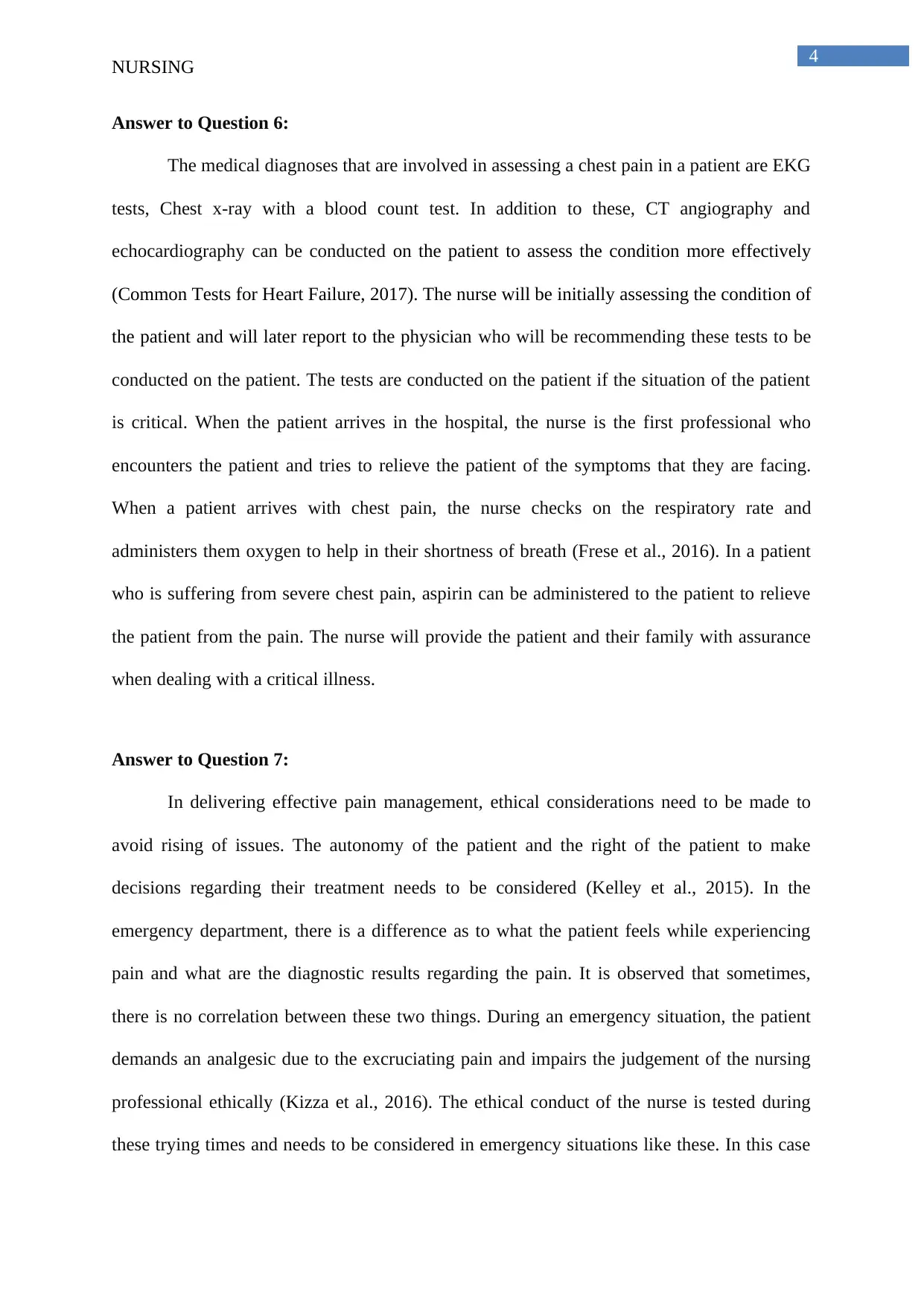
4
NURSING
Answer to Question 6:
The medical diagnoses that are involved in assessing a chest pain in a patient are EKG
tests, Chest x-ray with a blood count test. In addition to these, CT angiography and
echocardiography can be conducted on the patient to assess the condition more effectively
(Common Tests for Heart Failure, 2017). The nurse will be initially assessing the condition of
the patient and will later report to the physician who will be recommending these tests to be
conducted on the patient. The tests are conducted on the patient if the situation of the patient
is critical. When the patient arrives in the hospital, the nurse is the first professional who
encounters the patient and tries to relieve the patient of the symptoms that they are facing.
When a patient arrives with chest pain, the nurse checks on the respiratory rate and
administers them oxygen to help in their shortness of breath (Frese et al., 2016). In a patient
who is suffering from severe chest pain, aspirin can be administered to the patient to relieve
the patient from the pain. The nurse will provide the patient and their family with assurance
when dealing with a critical illness.
Answer to Question 7:
In delivering effective pain management, ethical considerations need to be made to
avoid rising of issues. The autonomy of the patient and the right of the patient to make
decisions regarding their treatment needs to be considered (Kelley et al., 2015). In the
emergency department, there is a difference as to what the patient feels while experiencing
pain and what are the diagnostic results regarding the pain. It is observed that sometimes,
there is no correlation between these two things. During an emergency situation, the patient
demands an analgesic due to the excruciating pain and impairs the judgement of the nursing
professional ethically (Kizza et al., 2016). The ethical conduct of the nurse is tested during
these trying times and needs to be considered in emergency situations like these. In this case
NURSING
Answer to Question 6:
The medical diagnoses that are involved in assessing a chest pain in a patient are EKG
tests, Chest x-ray with a blood count test. In addition to these, CT angiography and
echocardiography can be conducted on the patient to assess the condition more effectively
(Common Tests for Heart Failure, 2017). The nurse will be initially assessing the condition of
the patient and will later report to the physician who will be recommending these tests to be
conducted on the patient. The tests are conducted on the patient if the situation of the patient
is critical. When the patient arrives in the hospital, the nurse is the first professional who
encounters the patient and tries to relieve the patient of the symptoms that they are facing.
When a patient arrives with chest pain, the nurse checks on the respiratory rate and
administers them oxygen to help in their shortness of breath (Frese et al., 2016). In a patient
who is suffering from severe chest pain, aspirin can be administered to the patient to relieve
the patient from the pain. The nurse will provide the patient and their family with assurance
when dealing with a critical illness.
Answer to Question 7:
In delivering effective pain management, ethical considerations need to be made to
avoid rising of issues. The autonomy of the patient and the right of the patient to make
decisions regarding their treatment needs to be considered (Kelley et al., 2015). In the
emergency department, there is a difference as to what the patient feels while experiencing
pain and what are the diagnostic results regarding the pain. It is observed that sometimes,
there is no correlation between these two things. During an emergency situation, the patient
demands an analgesic due to the excruciating pain and impairs the judgement of the nursing
professional ethically (Kizza et al., 2016). The ethical conduct of the nurse is tested during
these trying times and needs to be considered in emergency situations like these. In this case
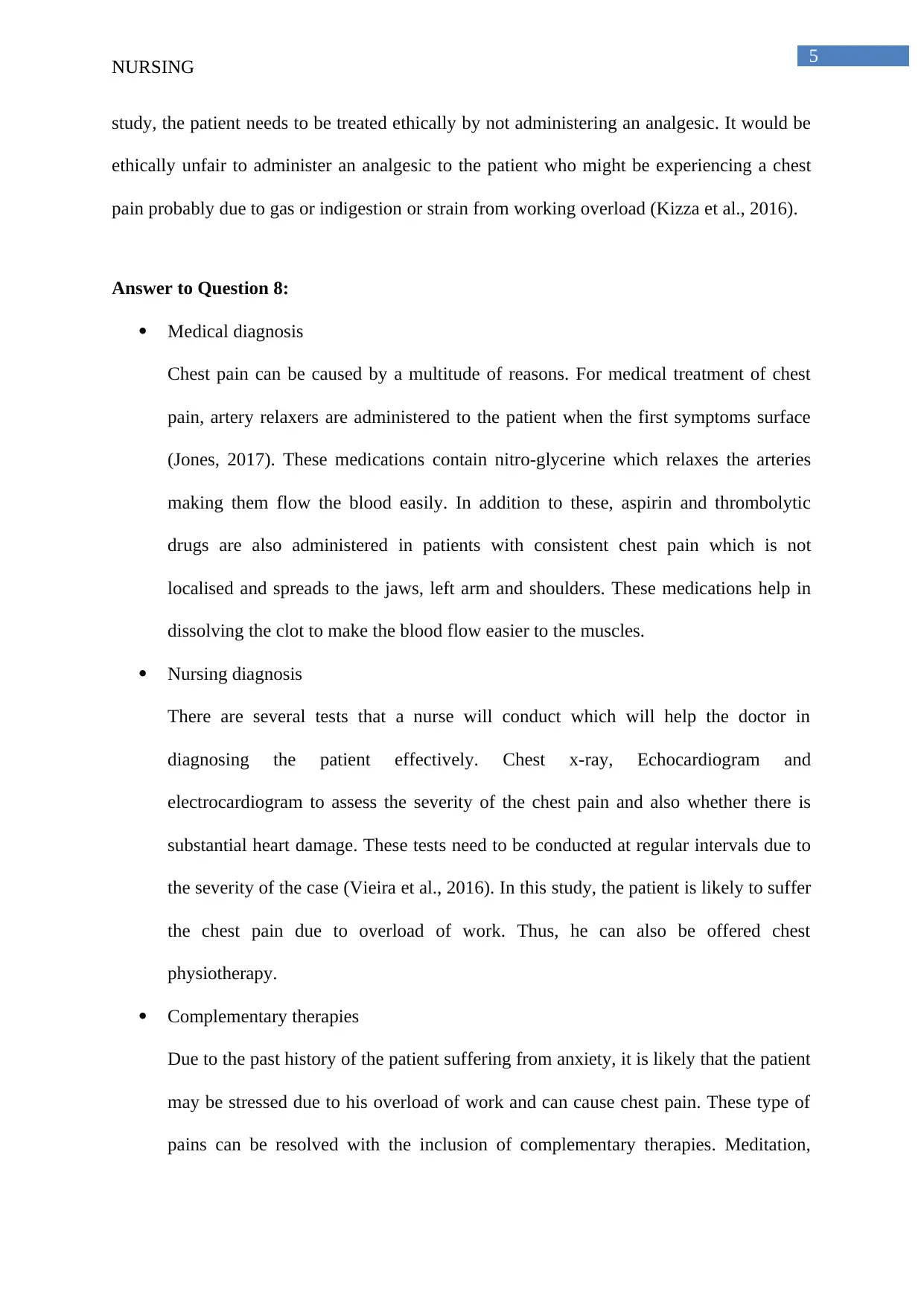
5
NURSING
study, the patient needs to be treated ethically by not administering an analgesic. It would be
ethically unfair to administer an analgesic to the patient who might be experiencing a chest
pain probably due to gas or indigestion or strain from working overload (Kizza et al., 2016).
Answer to Question 8:
Medical diagnosis
Chest pain can be caused by a multitude of reasons. For medical treatment of chest
pain, artery relaxers are administered to the patient when the first symptoms surface
(Jones, 2017). These medications contain nitro-glycerine which relaxes the arteries
making them flow the blood easily. In addition to these, aspirin and thrombolytic
drugs are also administered in patients with consistent chest pain which is not
localised and spreads to the jaws, left arm and shoulders. These medications help in
dissolving the clot to make the blood flow easier to the muscles.
Nursing diagnosis
There are several tests that a nurse will conduct which will help the doctor in
diagnosing the patient effectively. Chest x-ray, Echocardiogram and
electrocardiogram to assess the severity of the chest pain and also whether there is
substantial heart damage. These tests need to be conducted at regular intervals due to
the severity of the case (Vieira et al., 2016). In this study, the patient is likely to suffer
the chest pain due to overload of work. Thus, he can also be offered chest
physiotherapy.
Complementary therapies
Due to the past history of the patient suffering from anxiety, it is likely that the patient
may be stressed due to his overload of work and can cause chest pain. These type of
pains can be resolved with the inclusion of complementary therapies. Meditation,
NURSING
study, the patient needs to be treated ethically by not administering an analgesic. It would be
ethically unfair to administer an analgesic to the patient who might be experiencing a chest
pain probably due to gas or indigestion or strain from working overload (Kizza et al., 2016).
Answer to Question 8:
Medical diagnosis
Chest pain can be caused by a multitude of reasons. For medical treatment of chest
pain, artery relaxers are administered to the patient when the first symptoms surface
(Jones, 2017). These medications contain nitro-glycerine which relaxes the arteries
making them flow the blood easily. In addition to these, aspirin and thrombolytic
drugs are also administered in patients with consistent chest pain which is not
localised and spreads to the jaws, left arm and shoulders. These medications help in
dissolving the clot to make the blood flow easier to the muscles.
Nursing diagnosis
There are several tests that a nurse will conduct which will help the doctor in
diagnosing the patient effectively. Chest x-ray, Echocardiogram and
electrocardiogram to assess the severity of the chest pain and also whether there is
substantial heart damage. These tests need to be conducted at regular intervals due to
the severity of the case (Vieira et al., 2016). In this study, the patient is likely to suffer
the chest pain due to overload of work. Thus, he can also be offered chest
physiotherapy.
Complementary therapies
Due to the past history of the patient suffering from anxiety, it is likely that the patient
may be stressed due to his overload of work and can cause chest pain. These type of
pains can be resolved with the inclusion of complementary therapies. Meditation,
⊘ This is a preview!⊘
Do you want full access?
Subscribe today to unlock all pages.

Trusted by 1+ million students worldwide
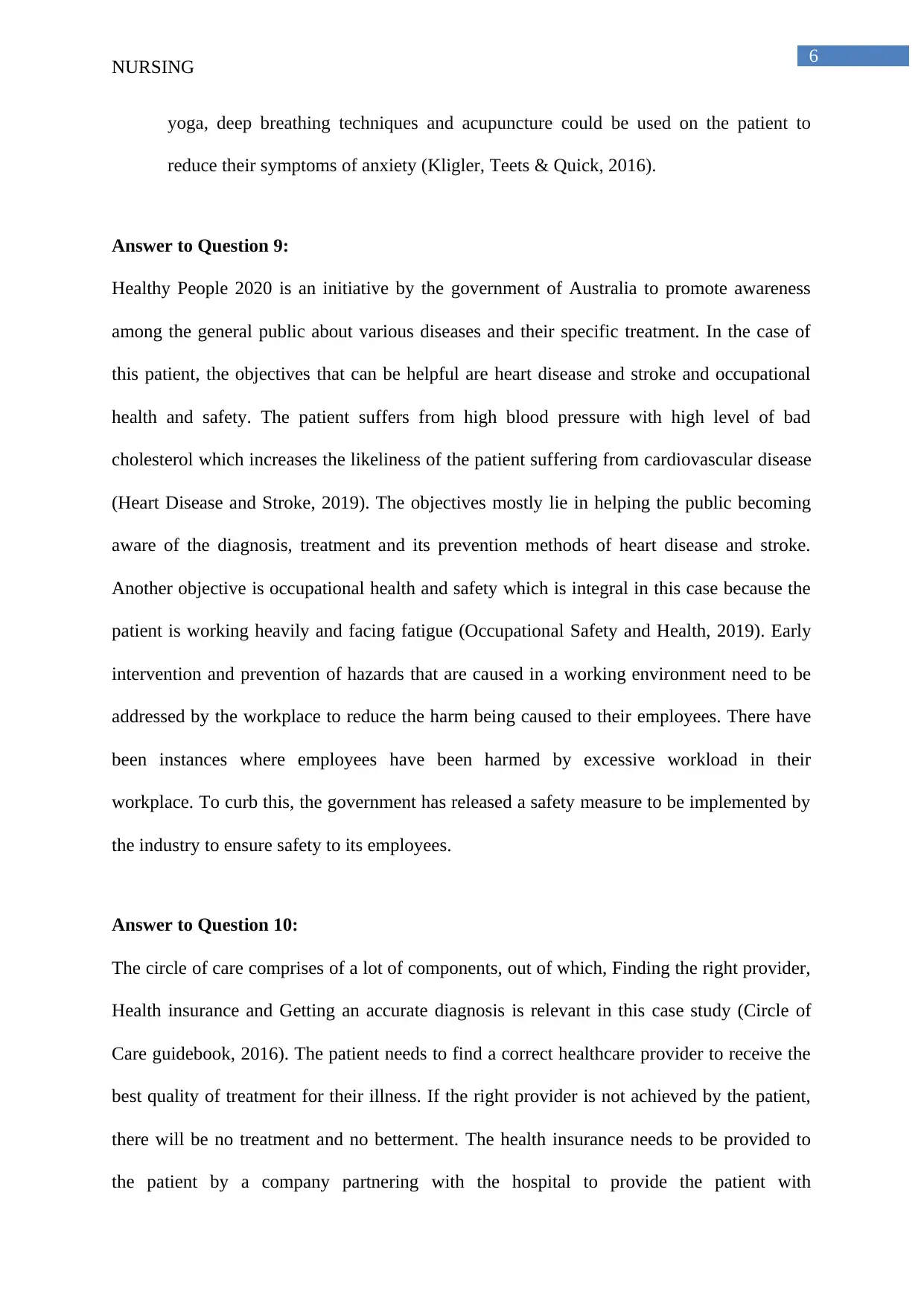
6
NURSING
yoga, deep breathing techniques and acupuncture could be used on the patient to
reduce their symptoms of anxiety (Kligler, Teets & Quick, 2016).
Answer to Question 9:
Healthy People 2020 is an initiative by the government of Australia to promote awareness
among the general public about various diseases and their specific treatment. In the case of
this patient, the objectives that can be helpful are heart disease and stroke and occupational
health and safety. The patient suffers from high blood pressure with high level of bad
cholesterol which increases the likeliness of the patient suffering from cardiovascular disease
(Heart Disease and Stroke, 2019). The objectives mostly lie in helping the public becoming
aware of the diagnosis, treatment and its prevention methods of heart disease and stroke.
Another objective is occupational health and safety which is integral in this case because the
patient is working heavily and facing fatigue (Occupational Safety and Health, 2019). Early
intervention and prevention of hazards that are caused in a working environment need to be
addressed by the workplace to reduce the harm being caused to their employees. There have
been instances where employees have been harmed by excessive workload in their
workplace. To curb this, the government has released a safety measure to be implemented by
the industry to ensure safety to its employees.
Answer to Question 10:
The circle of care comprises of a lot of components, out of which, Finding the right provider,
Health insurance and Getting an accurate diagnosis is relevant in this case study (Circle of
Care guidebook, 2016). The patient needs to find a correct healthcare provider to receive the
best quality of treatment for their illness. If the right provider is not achieved by the patient,
there will be no treatment and no betterment. The health insurance needs to be provided to
the patient by a company partnering with the hospital to provide the patient with
NURSING
yoga, deep breathing techniques and acupuncture could be used on the patient to
reduce their symptoms of anxiety (Kligler, Teets & Quick, 2016).
Answer to Question 9:
Healthy People 2020 is an initiative by the government of Australia to promote awareness
among the general public about various diseases and their specific treatment. In the case of
this patient, the objectives that can be helpful are heart disease and stroke and occupational
health and safety. The patient suffers from high blood pressure with high level of bad
cholesterol which increases the likeliness of the patient suffering from cardiovascular disease
(Heart Disease and Stroke, 2019). The objectives mostly lie in helping the public becoming
aware of the diagnosis, treatment and its prevention methods of heart disease and stroke.
Another objective is occupational health and safety which is integral in this case because the
patient is working heavily and facing fatigue (Occupational Safety and Health, 2019). Early
intervention and prevention of hazards that are caused in a working environment need to be
addressed by the workplace to reduce the harm being caused to their employees. There have
been instances where employees have been harmed by excessive workload in their
workplace. To curb this, the government has released a safety measure to be implemented by
the industry to ensure safety to its employees.
Answer to Question 10:
The circle of care comprises of a lot of components, out of which, Finding the right provider,
Health insurance and Getting an accurate diagnosis is relevant in this case study (Circle of
Care guidebook, 2016). The patient needs to find a correct healthcare provider to receive the
best quality of treatment for their illness. If the right provider is not achieved by the patient,
there will be no treatment and no betterment. The health insurance needs to be provided to
the patient by a company partnering with the hospital to provide the patient with
Paraphrase This Document
Need a fresh take? Get an instant paraphrase of this document with our AI Paraphraser

7
NURSING
reimbursement. This will enable the patient to stabilise their finances they will be
contributing to the healthcare and will be achieving a hassle-free monetary benefit (Circle of
Care guidebook, 2016). The patient deserves the right to get an accurate diagnosis as per the
circle of care. The accurate diagnosis enables the patient to get the proper treatment for the
symptoms they have been facing. If the accurate diagnosis is not provided to the patient, the
symptoms may escalate and the patient may experience a fatal condition.
Answer to Question 11:
Patient education is an integral part of healthcare that needs to be carried out. This
helps in the patient gathering all the necessary information about the diagnosis of their illness
and its treatment (Stimpfel et al., 2016). The healthcare professionals provide with education
to the patient which helps in achieving a better patient outcome (Rachuba et al., 2018). In this
case, the patient needs to be aware of the underlying side-effects that he might be suffering
because of his previous medical history. It is relevant for the patient to be given the
information about the side-effects that are likely to be experienced by the patient in the
subsequent years. It is not clear in the case study whether he was given the information about
side-effects of cholecystectomy and vasectomy. These two surgical procedures have been
observed to cause fatigue and indigestion in people over the years of the operation. The
patient has been complaining of fatigue and indigestion which can be caused by these
procedures in addition to the workload. The patient should be educated about the underlying
strains that his workload can cause on his health.
Answer to Question 12:
International Statistical Classification of Diseases and Related Health Problems have
been releasing medical codes generated by WHO to help the healthcare providers identify
and code health conditions. For chest pain, ICD-Code R07.9 is a billable ICD-10 code used
NURSING
reimbursement. This will enable the patient to stabilise their finances they will be
contributing to the healthcare and will be achieving a hassle-free monetary benefit (Circle of
Care guidebook, 2016). The patient deserves the right to get an accurate diagnosis as per the
circle of care. The accurate diagnosis enables the patient to get the proper treatment for the
symptoms they have been facing. If the accurate diagnosis is not provided to the patient, the
symptoms may escalate and the patient may experience a fatal condition.
Answer to Question 11:
Patient education is an integral part of healthcare that needs to be carried out. This
helps in the patient gathering all the necessary information about the diagnosis of their illness
and its treatment (Stimpfel et al., 2016). The healthcare professionals provide with education
to the patient which helps in achieving a better patient outcome (Rachuba et al., 2018). In this
case, the patient needs to be aware of the underlying side-effects that he might be suffering
because of his previous medical history. It is relevant for the patient to be given the
information about the side-effects that are likely to be experienced by the patient in the
subsequent years. It is not clear in the case study whether he was given the information about
side-effects of cholecystectomy and vasectomy. These two surgical procedures have been
observed to cause fatigue and indigestion in people over the years of the operation. The
patient has been complaining of fatigue and indigestion which can be caused by these
procedures in addition to the workload. The patient should be educated about the underlying
strains that his workload can cause on his health.
Answer to Question 12:
International Statistical Classification of Diseases and Related Health Problems have
been releasing medical codes generated by WHO to help the healthcare providers identify
and code health conditions. For chest pain, ICD-Code R07.9 is a billable ICD-10 code used
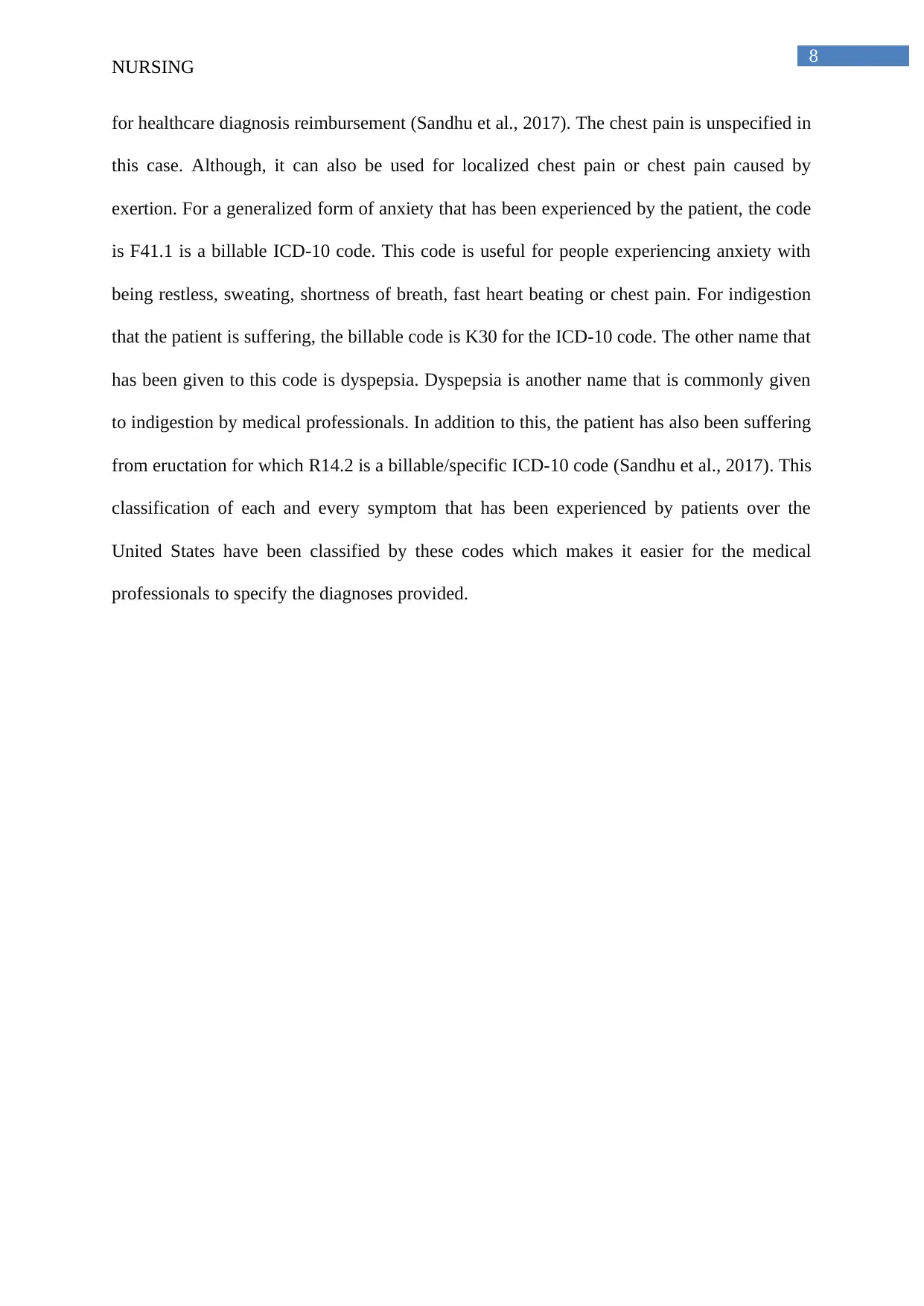
8
NURSING
for healthcare diagnosis reimbursement (Sandhu et al., 2017). The chest pain is unspecified in
this case. Although, it can also be used for localized chest pain or chest pain caused by
exertion. For a generalized form of anxiety that has been experienced by the patient, the code
is F41.1 is a billable ICD-10 code. This code is useful for people experiencing anxiety with
being restless, sweating, shortness of breath, fast heart beating or chest pain. For indigestion
that the patient is suffering, the billable code is K30 for the ICD-10 code. The other name that
has been given to this code is dyspepsia. Dyspepsia is another name that is commonly given
to indigestion by medical professionals. In addition to this, the patient has also been suffering
from eructation for which R14.2 is a billable/specific ICD-10 code (Sandhu et al., 2017). This
classification of each and every symptom that has been experienced by patients over the
United States have been classified by these codes which makes it easier for the medical
professionals to specify the diagnoses provided.
NURSING
for healthcare diagnosis reimbursement (Sandhu et al., 2017). The chest pain is unspecified in
this case. Although, it can also be used for localized chest pain or chest pain caused by
exertion. For a generalized form of anxiety that has been experienced by the patient, the code
is F41.1 is a billable ICD-10 code. This code is useful for people experiencing anxiety with
being restless, sweating, shortness of breath, fast heart beating or chest pain. For indigestion
that the patient is suffering, the billable code is K30 for the ICD-10 code. The other name that
has been given to this code is dyspepsia. Dyspepsia is another name that is commonly given
to indigestion by medical professionals. In addition to this, the patient has also been suffering
from eructation for which R14.2 is a billable/specific ICD-10 code (Sandhu et al., 2017). This
classification of each and every symptom that has been experienced by patients over the
United States have been classified by these codes which makes it easier for the medical
professionals to specify the diagnoses provided.
⊘ This is a preview!⊘
Do you want full access?
Subscribe today to unlock all pages.

Trusted by 1+ million students worldwide
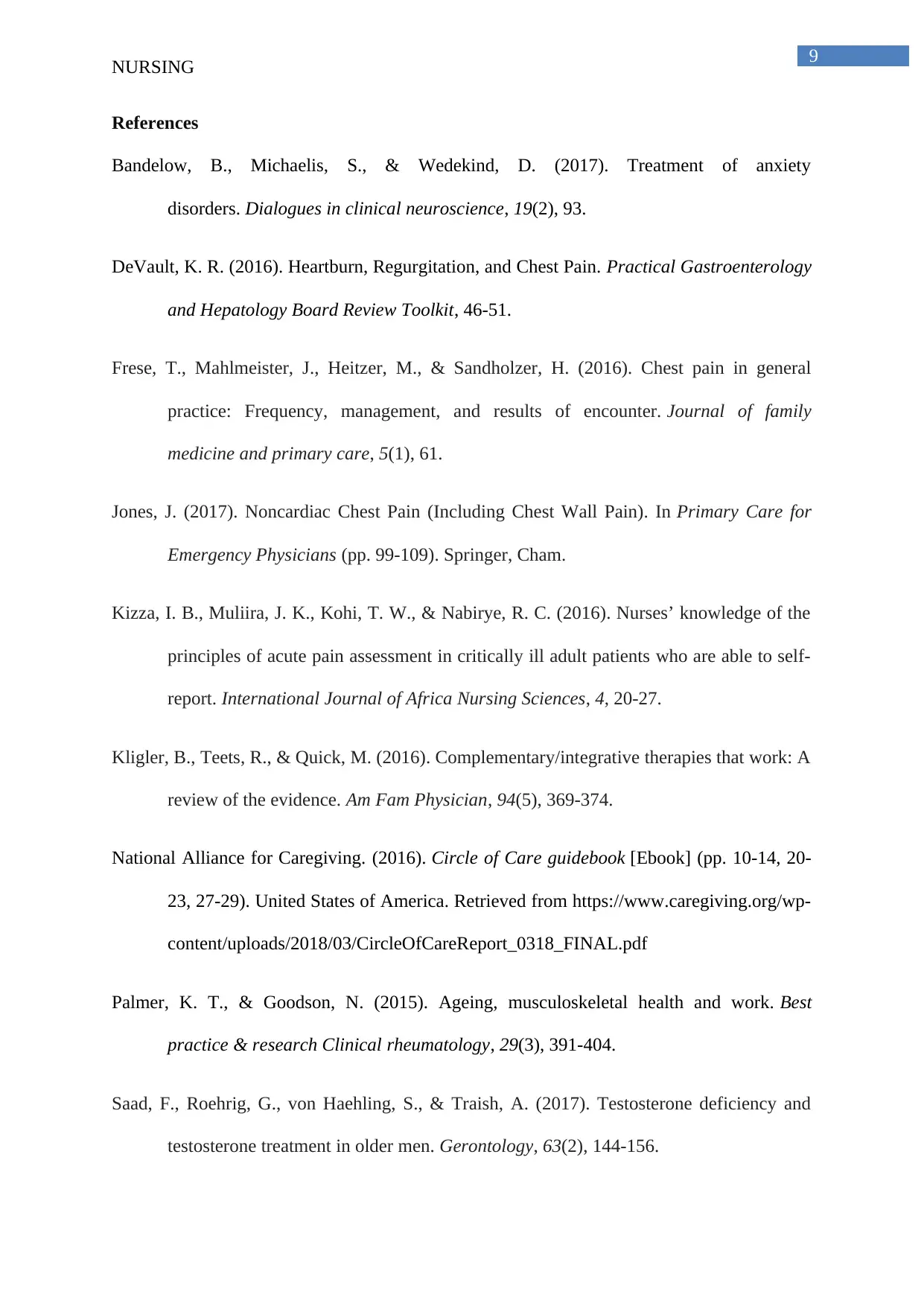
9
NURSING
References
Bandelow, B., Michaelis, S., & Wedekind, D. (2017). Treatment of anxiety
disorders. Dialogues in clinical neuroscience, 19(2), 93.
DeVault, K. R. (2016). Heartburn, Regurgitation, and Chest Pain. Practical Gastroenterology
and Hepatology Board Review Toolkit, 46-51.
Frese, T., Mahlmeister, J., Heitzer, M., & Sandholzer, H. (2016). Chest pain in general
practice: Frequency, management, and results of encounter. Journal of family
medicine and primary care, 5(1), 61.
Jones, J. (2017). Noncardiac Chest Pain (Including Chest Wall Pain). In Primary Care for
Emergency Physicians (pp. 99-109). Springer, Cham.
Kizza, I. B., Muliira, J. K., Kohi, T. W., & Nabirye, R. C. (2016). Nurses’ knowledge of the
principles of acute pain assessment in critically ill adult patients who are able to self-
report. International Journal of Africa Nursing Sciences, 4, 20-27.
Kligler, B., Teets, R., & Quick, M. (2016). Complementary/integrative therapies that work: A
review of the evidence. Am Fam Physician, 94(5), 369-374.
National Alliance for Caregiving. (2016). Circle of Care guidebook [Ebook] (pp. 10-14, 20-
23, 27-29). United States of America. Retrieved from https://www.caregiving.org/wp-
content/uploads/2018/03/CircleOfCareReport_0318_FINAL.pdf
Palmer, K. T., & Goodson, N. (2015). Ageing, musculoskeletal health and work. Best
practice & research Clinical rheumatology, 29(3), 391-404.
Saad, F., Roehrig, G., von Haehling, S., & Traish, A. (2017). Testosterone deficiency and
testosterone treatment in older men. Gerontology, 63(2), 144-156.
NURSING
References
Bandelow, B., Michaelis, S., & Wedekind, D. (2017). Treatment of anxiety
disorders. Dialogues in clinical neuroscience, 19(2), 93.
DeVault, K. R. (2016). Heartburn, Regurgitation, and Chest Pain. Practical Gastroenterology
and Hepatology Board Review Toolkit, 46-51.
Frese, T., Mahlmeister, J., Heitzer, M., & Sandholzer, H. (2016). Chest pain in general
practice: Frequency, management, and results of encounter. Journal of family
medicine and primary care, 5(1), 61.
Jones, J. (2017). Noncardiac Chest Pain (Including Chest Wall Pain). In Primary Care for
Emergency Physicians (pp. 99-109). Springer, Cham.
Kizza, I. B., Muliira, J. K., Kohi, T. W., & Nabirye, R. C. (2016). Nurses’ knowledge of the
principles of acute pain assessment in critically ill adult patients who are able to self-
report. International Journal of Africa Nursing Sciences, 4, 20-27.
Kligler, B., Teets, R., & Quick, M. (2016). Complementary/integrative therapies that work: A
review of the evidence. Am Fam Physician, 94(5), 369-374.
National Alliance for Caregiving. (2016). Circle of Care guidebook [Ebook] (pp. 10-14, 20-
23, 27-29). United States of America. Retrieved from https://www.caregiving.org/wp-
content/uploads/2018/03/CircleOfCareReport_0318_FINAL.pdf
Palmer, K. T., & Goodson, N. (2015). Ageing, musculoskeletal health and work. Best
practice & research Clinical rheumatology, 29(3), 391-404.
Saad, F., Roehrig, G., von Haehling, S., & Traish, A. (2017). Testosterone deficiency and
testosterone treatment in older men. Gerontology, 63(2), 144-156.
Paraphrase This Document
Need a fresh take? Get an instant paraphrase of this document with our AI Paraphraser
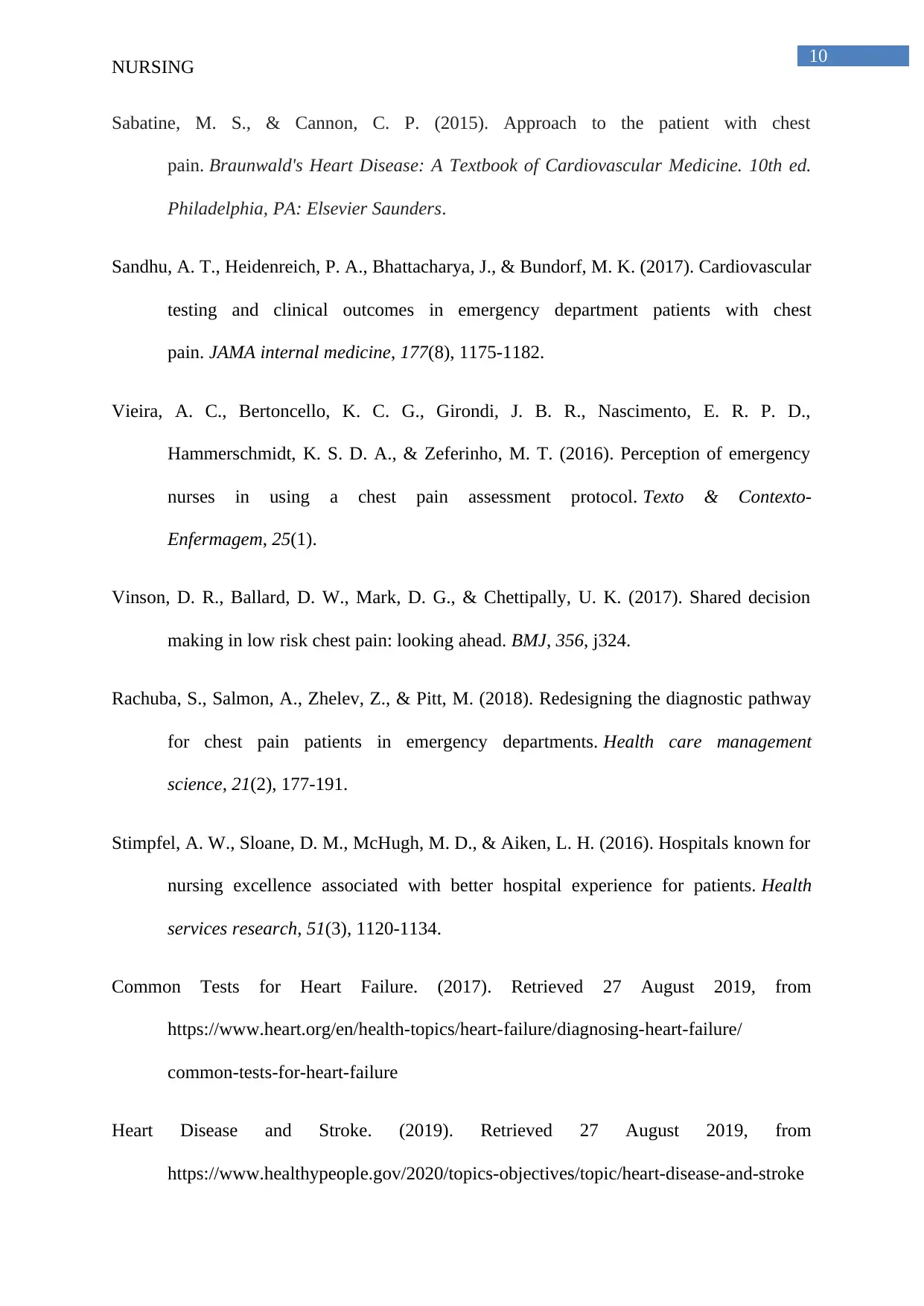
10
NURSING
Sabatine, M. S., & Cannon, C. P. (2015). Approach to the patient with chest
pain. Braunwald's Heart Disease: A Textbook of Cardiovascular Medicine. 10th ed.
Philadelphia, PA: Elsevier Saunders.
Sandhu, A. T., Heidenreich, P. A., Bhattacharya, J., & Bundorf, M. K. (2017). Cardiovascular
testing and clinical outcomes in emergency department patients with chest
pain. JAMA internal medicine, 177(8), 1175-1182.
Vieira, A. C., Bertoncello, K. C. G., Girondi, J. B. R., Nascimento, E. R. P. D.,
Hammerschmidt, K. S. D. A., & Zeferinho, M. T. (2016). Perception of emergency
nurses in using a chest pain assessment protocol. Texto & Contexto-
Enfermagem, 25(1).
Vinson, D. R., Ballard, D. W., Mark, D. G., & Chettipally, U. K. (2017). Shared decision
making in low risk chest pain: looking ahead. BMJ, 356, j324.
Rachuba, S., Salmon, A., Zhelev, Z., & Pitt, M. (2018). Redesigning the diagnostic pathway
for chest pain patients in emergency departments. Health care management
science, 21(2), 177-191.
Stimpfel, A. W., Sloane, D. M., McHugh, M. D., & Aiken, L. H. (2016). Hospitals known for
nursing excellence associated with better hospital experience for patients. Health
services research, 51(3), 1120-1134.
Common Tests for Heart Failure. (2017). Retrieved 27 August 2019, from
https://www.heart.org/en/health-topics/heart-failure/diagnosing-heart-failure/
common-tests-for-heart-failure
Heart Disease and Stroke. (2019). Retrieved 27 August 2019, from
https://www.healthypeople.gov/2020/topics-objectives/topic/heart-disease-and-stroke
NURSING
Sabatine, M. S., & Cannon, C. P. (2015). Approach to the patient with chest
pain. Braunwald's Heart Disease: A Textbook of Cardiovascular Medicine. 10th ed.
Philadelphia, PA: Elsevier Saunders.
Sandhu, A. T., Heidenreich, P. A., Bhattacharya, J., & Bundorf, M. K. (2017). Cardiovascular
testing and clinical outcomes in emergency department patients with chest
pain. JAMA internal medicine, 177(8), 1175-1182.
Vieira, A. C., Bertoncello, K. C. G., Girondi, J. B. R., Nascimento, E. R. P. D.,
Hammerschmidt, K. S. D. A., & Zeferinho, M. T. (2016). Perception of emergency
nurses in using a chest pain assessment protocol. Texto & Contexto-
Enfermagem, 25(1).
Vinson, D. R., Ballard, D. W., Mark, D. G., & Chettipally, U. K. (2017). Shared decision
making in low risk chest pain: looking ahead. BMJ, 356, j324.
Rachuba, S., Salmon, A., Zhelev, Z., & Pitt, M. (2018). Redesigning the diagnostic pathway
for chest pain patients in emergency departments. Health care management
science, 21(2), 177-191.
Stimpfel, A. W., Sloane, D. M., McHugh, M. D., & Aiken, L. H. (2016). Hospitals known for
nursing excellence associated with better hospital experience for patients. Health
services research, 51(3), 1120-1134.
Common Tests for Heart Failure. (2017). Retrieved 27 August 2019, from
https://www.heart.org/en/health-topics/heart-failure/diagnosing-heart-failure/
common-tests-for-heart-failure
Heart Disease and Stroke. (2019). Retrieved 27 August 2019, from
https://www.healthypeople.gov/2020/topics-objectives/topic/heart-disease-and-stroke
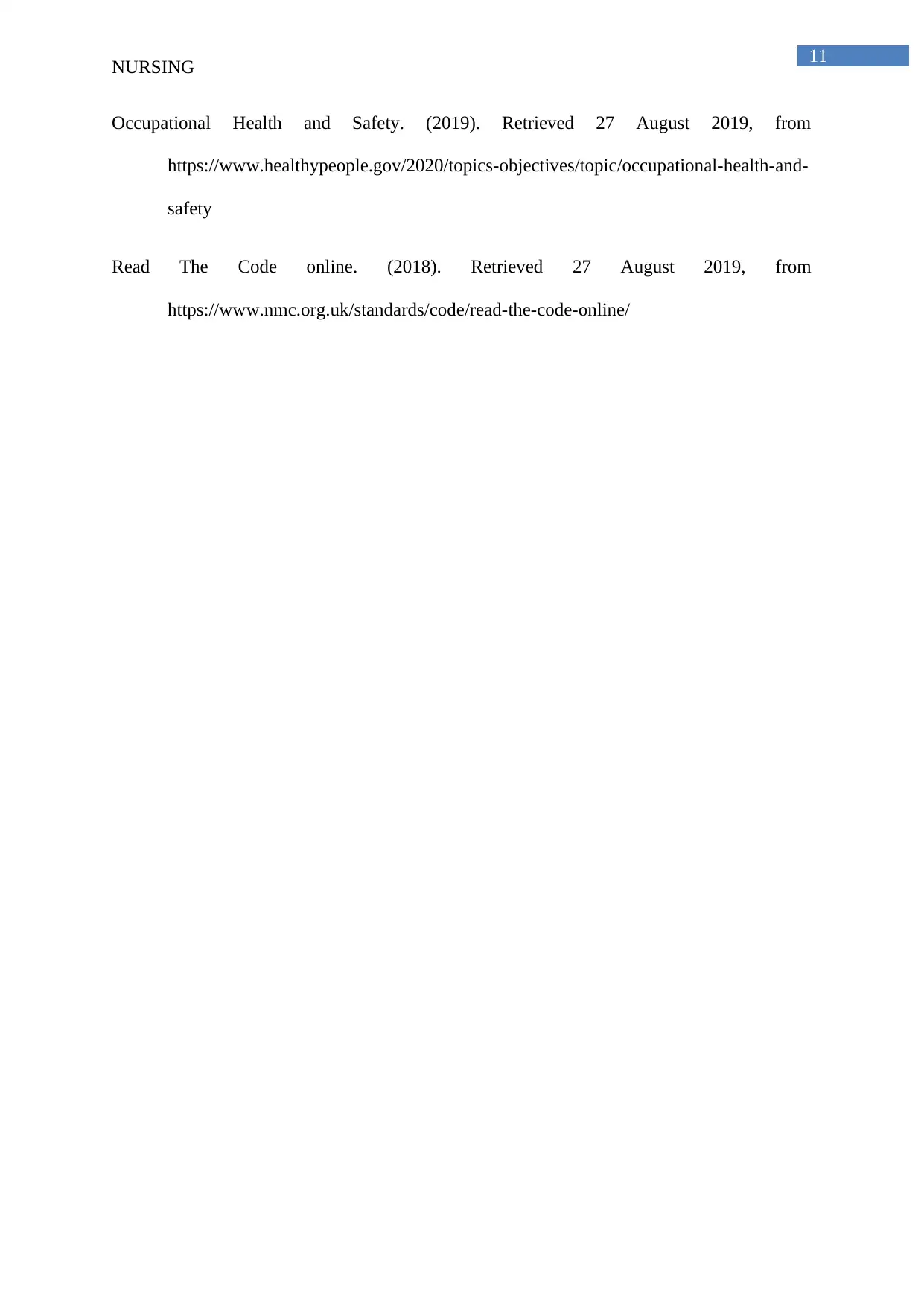
11
NURSING
Occupational Health and Safety. (2019). Retrieved 27 August 2019, from
https://www.healthypeople.gov/2020/topics-objectives/topic/occupational-health-and-
safety
Read The Code online. (2018). Retrieved 27 August 2019, from
https://www.nmc.org.uk/standards/code/read-the-code-online/
NURSING
Occupational Health and Safety. (2019). Retrieved 27 August 2019, from
https://www.healthypeople.gov/2020/topics-objectives/topic/occupational-health-and-
safety
Read The Code online. (2018). Retrieved 27 August 2019, from
https://www.nmc.org.uk/standards/code/read-the-code-online/
⊘ This is a preview!⊘
Do you want full access?
Subscribe today to unlock all pages.

Trusted by 1+ million students worldwide
1 out of 12
Related Documents
Your All-in-One AI-Powered Toolkit for Academic Success.
+13062052269
info@desklib.com
Available 24*7 on WhatsApp / Email
![[object Object]](/_next/static/media/star-bottom.7253800d.svg)
Unlock your academic potential
Copyright © 2020–2025 A2Z Services. All Rights Reserved. Developed and managed by ZUCOL.




